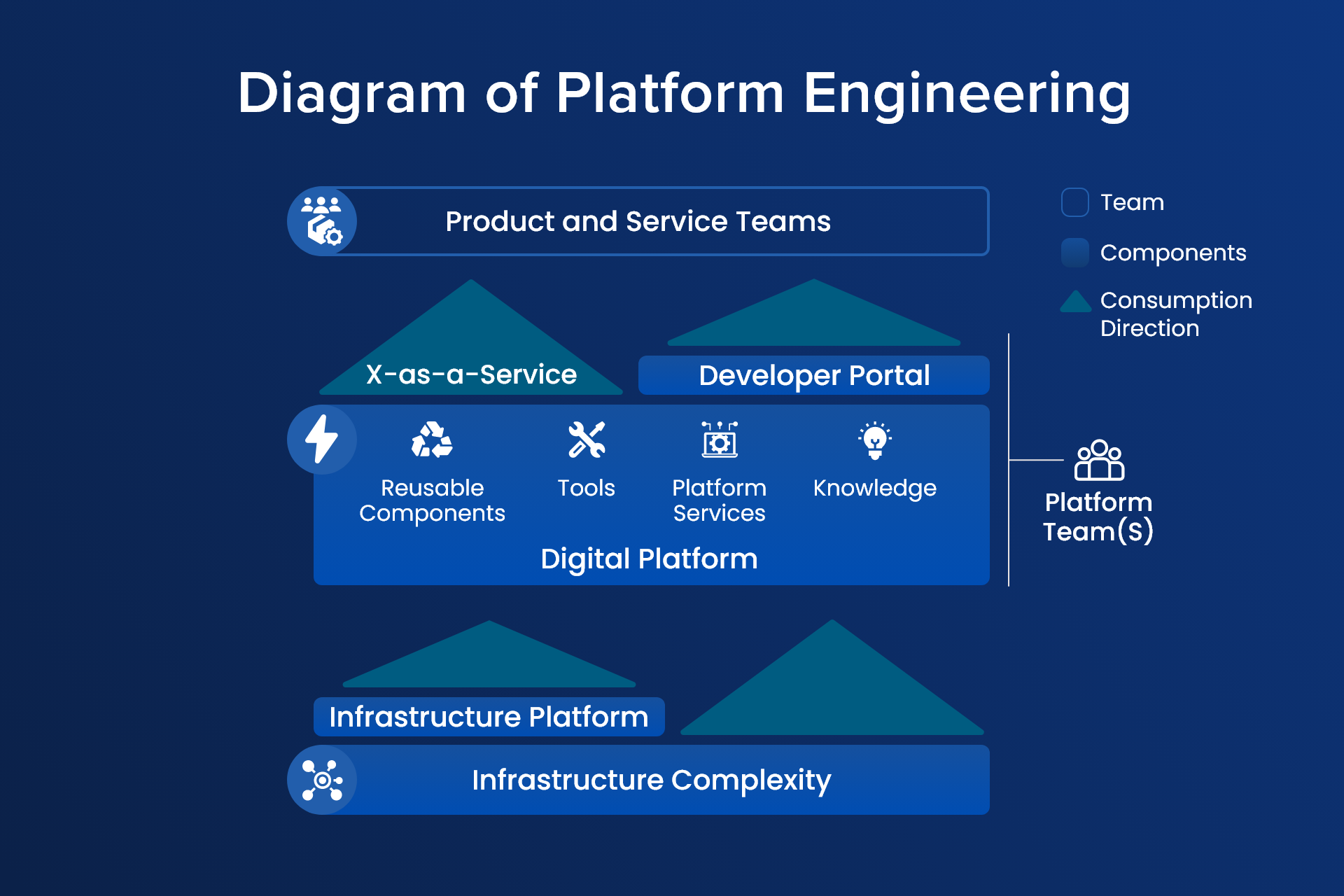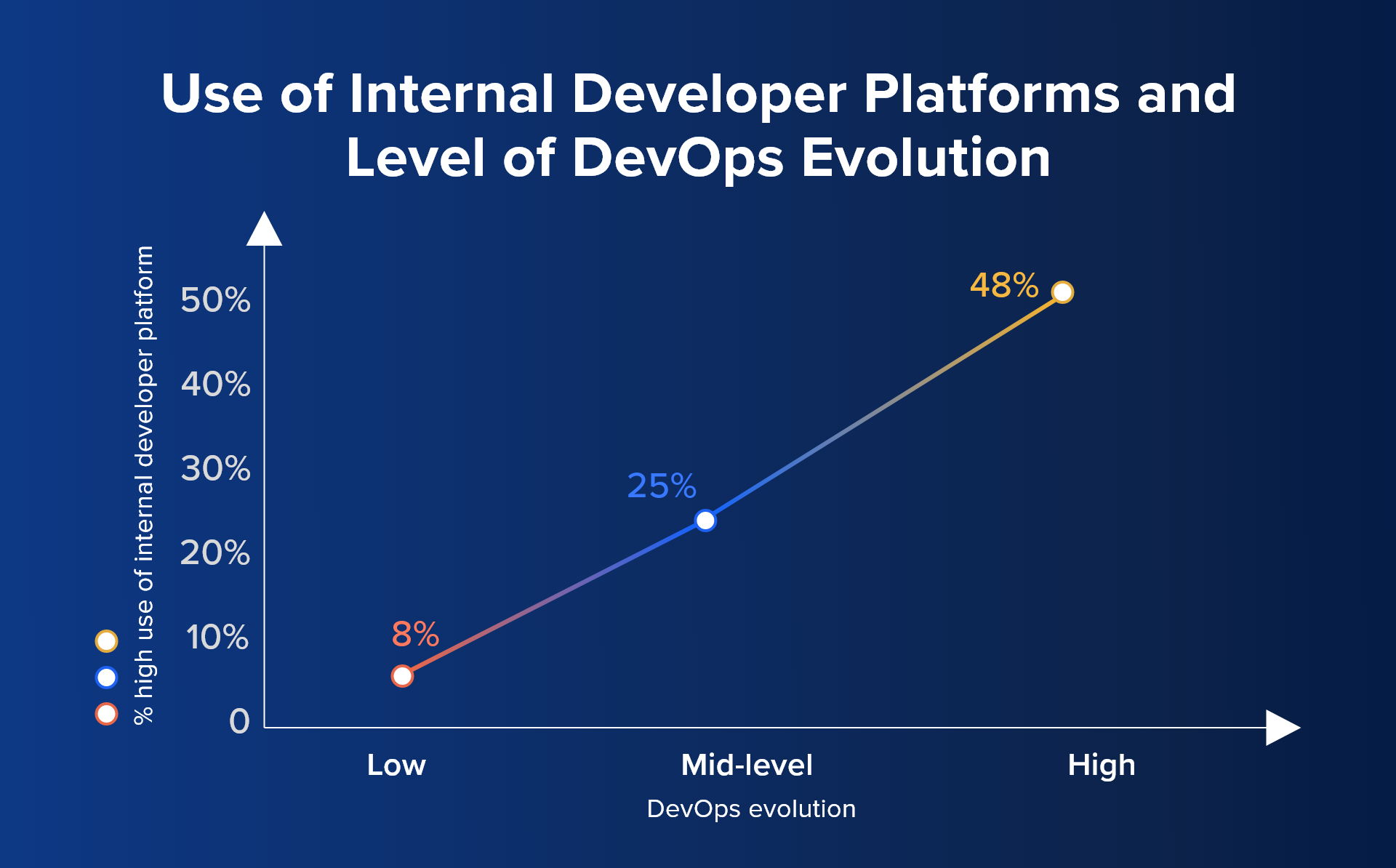Platform engineering has been gaining popularity in recent times, with some likening it to the next iteration of DevOps. Gartner has listed it as one of the top strategic trends of 2024 – and has predicted that 80% of large software engineering organizations will establish platform engineering teams by 2026.
The DevOps movement and penetration of new technology practices like containerization, infrastructure as code, serverless computing that came with the beginning of the cloud era demanded new skills and additional time for non-core tasks from the engineering team. Recognizing this, some early adopters and organizations rethought the practices and started building platforms that would empower developers to reduce their cognitive load and enable them to focus on application development.
What is Platform Engineering?
Platform engineering is the discipline of designing and building toolchains and workflows to empower developers with self-service capabilities and boost productivity in software engineering organizations. Platform engineers provide an integrated product most often referred to as an Internal Developer Platform (IDP). An IDP encompasses a curated set of tools, capabilities, and processes selected and packaged by platform engineers. The aim is to reduce cognitive load on developers through frictionless, self-servicing developer experience enabling them to produce valuable software with minimal overheads. Successfully engineered platforms provide as much abstraction level an individual developer interacting with the IDP wants befitting the team’s preferred workflow.

Evolution of Platform Engineering from DevOps
Around the time cloud started to gain popularity, the concept of DevOps was born. While the transition to cloud-native drove huge improvements in areas like scalability, availability, and operability, it also meant setups became a lot more complex. The industry championed DevOps as a solution to achieve a high-performing setup. Developers should be able to deploy and run their apps and services end-to-end. “You build it, you run it”.
It became a bit unrealistic target for most companies to invest their small pool of talent for both development and DevOps. When a regular engineering organization tries to implement true DevOps, a series of antipatterns emerge. Senior developers end up taking responsibility for managing environments, infrastructure, etc. This leads to a setup where “shadow operations” are performed by the same engineers whose input in terms of coding and product development is most valuable. The senior engineer now becomes responsible for the setup and needs to solve requests from more junior colleagues, including helping the inexperienced colleague. Instead of optimization the organization ends up misusing its most expensive and talented resources, and cannot ship features with the same speed and reliability. A stunning 44% of low performing organizations experience the above antipattern. On the other hand, top performing organizations ensure their developers can run their apps and services, without the constant need for help from senior colleagues.
This is where the requirement of platform engineering arises to build IDPs. IDPs allow developers to pick the right level of abstraction to run their apps and services, depending on their preferences. Do they like messing around with Helm charts, YAML files, and Terraform modules? Great, they can do so. Are they a junior frontend who doesn’t care if the app is running on EKS? Fantastic, they can just self-serve an environment that comes fully provisioned with everything they need to deploy and test their code, without worrying about where it runs.

Principles of Platform Engineering
A successful platform engineering team is governed by a set of principles. These principles lay the groundwork for designing, building, and maintaining platforms. Understanding these principles is crucial for platform teams and organizations at large for the success of their platforms.
Standardization
With teams using a diverse set of tools and processes, collaboration becomes critical. And that’s why standardization is the core principle of platform engineering. It helps promote consistency and efficiency across the development process. Standardization helps determine best practices, coding standards, architectural patterns, and a clear set of guidelines that helps create a cohesive and productive development environment.
Automation
Platform teams must seek opportunities to automate repetitive and time-consuming tasks like infrastructure provisioning, application deployment, and testing. With automation, developers can spin up development environments that are consistent and reliable. Automation not only reduces the time but also reduces human errors that can creep in and slow down the process.
Abstraction
Abstraction is a key principle of platform engineering as we want our developers to focus on their core expertise only. With abstraction, we can shield our developers from the complexities of the underlying infrastructure and in turn simplify development and improve collaboration. While abstraction is important, it’s important to strike a balance between flexibility and abstraction.
These principles provide a solid foundation and emphasize automation, scalability, and reliability.
Objectives of Platform Engineering
An IDP is a glue that binds all the tech and tools for paving a golden path for self servicing developers. Rather than letting everybody operate everything and having to understand the entire toolchain it is important to set clearly defined objectives for the success of platform engineering. Following are the ways to clearly define your objectives for platform engineering:
Treat your platform as a product
Expanding on the product focus, the platform team needs to be driven by a product mindset. They need to focus on what provides real value to their internal customers, the app developers, based on the feedback they received from them. They should ensure to ship features based on this feedback loop and don’t get distracted by a newly launched technology in the market.
Focus on common problems
Platform teams prevent other teams within from reinventing the wheel by tackling shared problems over and over. It’s key to figure out what these common issues are: start by understanding developer pain points and friction areas that cause slowdowns in development. This information can be gathered both qualitatively through developers’ feedback and quantitatively, by looking at engineering KPIs.
Glue is valuable
Often platform teams are seen as a pure cost center because they don’t ship any actual product features for the end user. They are only gluing together the development system after all. However this is an extremely valuable role. Once the platform engineers have designed the golden paths and paved roads for development teams, the main value is to be that sticky glue that brings the toolchain together and ensures a smooth self-service workflow for other engineers.
Don’t reinvent the wheel
Platform teams should prevent other teams within the organization from reinventing the wheel and finding new creative solutions to the same problems. Platform teams should always ask what is their differentiator. Instead of building in-house alternatives to a proven CI system or a metrics dashboard and competing against large enterprises, they should focus on the specific needs of their organization and tailor off-the-shelf solutions to their requirements. Commercial competitors are more likely to optimize for more generic needs of the industry anyway.
Tools to Get You Started with Platform Engineering
While organizations can choose to build platforms from scratch, there are a lot of tools in the market that help build platforms with basic capabilities built in. From automation solutions to application discovery and integration, there are tools that aid platform engineering teams in building, maintaining, and optimizing robust platforms. These tools help build platforms, enable seamless collaboration, and increase developer experience.
Backstage
Backstage is an open-source platform engineering tool developed by Spotify. It provides a unified interface for developers to access all the essential tools and services needed to build and manage applications. Its key features include a service catalog, enabling developers to discover and utilize internal tools seamlessly. It has support for plugins that make it easy to integrate it with other tools. Backstage facilitates easy collaboration between teams, improving visibility and knowledge sharing across the organization.
Kratix
Kratix is another open-source platform engineering tool designed to automate infrastructure management and streamline the development process. It supports platform teams that deliver a curated Kubernetes-native platform API. It leverages GitOps workflows and Kubernetes-native constructs that allow platform teams to build robust platforms. Kratix enables the injection of business-specific requirements by means of Kratix Promises.
Crossplane
Crossplane is an open-source tool that automates infrastructure via declarative APIs. It helps create tailored platform solutions, automate resource provisioning, reduce manual intervention, and enhance scalability and reliability. It comes with features like packages that provide extensibility and RBAC for security along with a suite of providers that allow it to provision infrastructure on external service.
Humanitec
Humanitec is a comprehensive platform engineering tool that empowers teams to easily build, deploy, and manage platforms. It helps you define a workload specification that can be used by Score, their platform orchestrator, to build enterprise-grade platforms faster. You can extend the functionality of your platform using drivers. Lastly, it has some predefined architectures for various cloud providers that you can leverage while building your platforms.
Port
Port is another platform that allows you to build developer platforms. It comes with a rich software catalog for microservices and CI/CD and allows you to bring your model and plug it in too. It has a role-based access control feature for enhanced security and a scorecard feature that helps you set quality standards for your platform engineering teams.
Practical Benefits of Platform Engineering
While platforms have emerged as powerful tools to streamline operations and improve productivity, it is essential to evaluate the benefits of a platform for your enterprise. Following are some of the key benefits platforms contribute towards developer experience and overall productivity:
Reduced application complexity
As applications grow in complexity it is important to maintain a standard, unified work environment. Platforms standardize workflows and provide necessary tooling development, deployment, and to improve collaboration between developers.
Frequent releases
One of the biggest challenges that development teams face is inconsistency in the development, pre-production, and production setups. This hampers their productivity greatly which in turn leads to slower releases. Platforms facilitate faster testing and reliable deployment of applications with their automation capabilities and CI/CD pipelines. This in turn helps faster and frequent release for critically time-bound projects.
Resource optimization
Platforms automate infrastructure provisioning and de-provisioning and optimize resource utilization. They can scale on-demand helping organizations to cut costs and adapt to a pay-as-you-go model.
Security & compliance
Platforms enforce security best practices on teams and check that the application is compliant with industry standards and regulations. The unified environment also ensures consistency of coding standards across teams.
Conclusion
Reasons to get a platform become clear only when you consider the diverse requirements and challenges that your teams face. What is the ideal development platform for one company may be useless to another. Even within the same company, different development teams may have entirely different needs. Analyzing the workflow and challenges of different teams in an organization is important before building IDPs. This in turn requires in-depth technical expertise and a broad understanding of both technology and business. Hiring platform engineers or an experienced IDP builder can help to benefit the organization reduce workloads, optimize productivity, and evolve into a DevOps successful organization.
